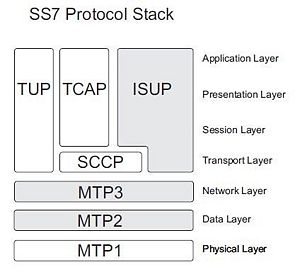SS7
SS7 is a signaling protocol which is used to set up and tear down phone calls. It also provides support for such functionality as local number portability, Short Messaging Service (SMS), prepaid billing and number translation.
The configuration of SS7 requires that the physical layer, through to the transport layer, and up to the application layer be configured. SS7 configuration involves configuring values for MTP2 Layer, MTP3 Layer, and ISUP.
A conceptual illustration of the SS7 protocol stack is shown on the right.
Contents |
Short history of SS7
Starting in the 1960s, public switched telephone networks (PSTN) were built using analog technologies and multiple in-band signaling methods. The growth of common fixed telephony end-users and the increasing demand for more advance services quickly made old protocols such as R1 CAS, R2 CAS to become less attractive for service providers. The ISDN protocol revolution was a big step in the telecom industry going from an in-band signaling protocol (using tones, stolen bits from voice channel or dedicated channel) to an out-of-band signaling (separated from voice channels) with message based primitives fitted for digital networks. Even if ISDN was fixing many problems of older protocols, its mass deployment in core networks never really occurred thus leaving providers with a complex hierarchy of equipments interworking with each other (or at least trying to). Although ISDN offered an easier way to provide supplementary services (i.e. call hold, call transfer) to the end-users, ISDN progressively migrated toward the edge of the network closer to the end-user. In addition, no equipment provider really implemented the ISDN base specifications thus creating lots of local variants and headaches to system integrators.
At that point, international consortia had already started working on a unified way of establishing calls, to provide numerous services (including those already supported by ISDN and older protocols) and to be able to build new applications (services) without having to change the whole network architecture. SS7 (or Signaling System 7) took many years before being deployed all over the world but is now achieving what it was designed to do: offer an overall communication standard providing many services and being able to grow with public’s demands. Even if local variants were still implemented and multiple revisions of the protocol occurred, this signaling protocol currently connects most major telephone networks all over the world. It also added a very critical feature to every network all over the world: robustness and fault tolerance. Being layered in different functional groups, SS7 was built so that different nodes in the network don’t need to implement every portion of the protocol stack if they don’t require to. Following sections will describe more in details those layers and particularly the call control layer ISUP.
TelcoBridges and SS7
TelcoBridges provides SS7 support with all of its media gateway, VAS development platform and monitoring devices. SS7 functionality is licensed separately and can be provided at initial purchase or added later on via a software license upgrade.
SS7 signaling is configured once for the entire Tmedia or Tdev system. Any one Tdev unit is capable of running the entire SS7 signaling stack for all the Tdev units in a system.
Systems developed using TelcoBridges hardware can support up to a maximum of 64 point codes. It is worth noting that a single pointcode can be used for 2 or more devices configured as a single system.
High availability (HA) has been designed into the architecture of the Tmedia product such that the failure of an SS7 stack on one Tmedia unit will be taken over by the SS7 stack of another Tmedia unit.
Click for further information on:
- Supported MTP2 standards and variants
- Supported MTP3 standards and variants
- Supported ISUP standards and variants
Related actions
